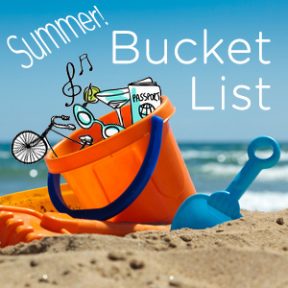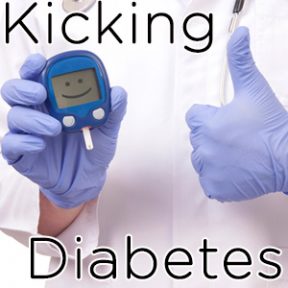 Can’t believe it’s already mid-July! I love the long days when it’s still sunny out after work and I have time to ride my bike along the beach before sunset.
Can’t believe it’s already mid-July! I love the long days when it’s still sunny out after work and I have time to ride my bike along the beach before sunset.
With just a few weeks left before kids head back to school and autumn arrives, jot down some ideas for your Summer Bucket List!
Whether it’s for yourself or for the whole family, write them down, put them on your calendar, and start making arrangements NOW.
Here are some ideas:
For YOU:
1. Road Trip — get away from stress and every-day hassles by heading out of town and relaxing at a resort or nice hotel with amenities to revitalize you!
2. Day Spa — get pampered from head to toe — full-body massage and facial!
3. Make Over — learn how to take care of your skin and create a new look with makeup!
4. New Wardrobe — buy a new outfit, and if you can afford it, a new wardrobe!
YOU DESERVE THIS!
For the FAMILY:
1. Movie Marathon — select 3 or 4 new movies and spend the day/night going to see all of them!
2. TV Marathon — watch an entire season in one weekend. Turn off the cell phones, make the popcorn, and indulge yourselves!
3. Beach/Lake Day — grab bathing suits and sunscreen, then head to the water!
4. Amusement Park — head out to your favorite amusement park to load up on the adrenaline rush, junk food, and people watching!
5. Party Time — invite all of the friends and family you were hoping to see during the summer (but just never got around to it)!
Put this on your calendar and make the calls! You’ll be glad you did once fall arrives and the days get shorter.
 Can’t believe it’s already mid-July! I love the long days when it’s still sunny out after work and I have time to ride my bike along the beach before sunset.
Can’t believe it’s already mid-July! I love the long days when it’s still sunny out after work and I have time to ride my bike along the beach before sunset.
With just a few weeks left before kids head back to school and autumn arrives, jot down some ideas for your Summer Bucket List!
Whether it’s for yourself or for the whole family, write them down, put them on your calendar, and start making arrangements NOW.
Here are some ideas:
For YOU:
1. Road Trip — get away from stress and every-day hassles by heading out of town and relaxing at a resort or nice hotel with amenities to revitalize you!
2. Day Spa — get pampered from head to toe — full-body massage and facial!
3. Make Over — learn how to take care of your skin and create a new look with makeup!
4. New Wardrobe — buy a new outfit, and if you can afford it, a new wardrobe!
YOU DESERVE THIS!
For the FAMILY:
1. Movie Marathon — select 3 or 4 new movies and spend the day/night going to see all of them!
2. TV Marathon — watch an entire season in one weekend. Turn off the cell phones, make the popcorn, and indulge yourselves!
3. Beach/Lake Day — grab bathing suits and sunscreen, then head to the water!
4. Amusement Park — head out to your favorite amusement park to load up on the adrenaline rush, junk food, and people watching!
5. Party Time — invite all of the friends and family you were hoping to see during the summer (but just never got around to it)!
Put this on your calendar and make the calls! You’ll be glad you did once fall arrives and the days get shorter.
 I wish I had a green thumb. My grandmother could grow anything just about anywhere. She would till the soil and build elaborate cages for her veggies. But sadly, I didn’t inherit her genes. I have started plants from seeds and cuttings, and I’ve purchased exotic flowering plants, only to watch them inevitably wither away and die. My mother suggested that I grow philodendrons because, well, anybody can grow them, even me!
I wish I had a green thumb. My grandmother could grow anything just about anywhere. She would till the soil and build elaborate cages for her veggies. But sadly, I didn’t inherit her genes. I have started plants from seeds and cuttings, and I’ve purchased exotic flowering plants, only to watch them inevitably wither away and die. My mother suggested that I grow philodendrons because, well, anybody can grow them, even me!
That’s why my house and offices are stuffed with philodendrons. I’ve taken clippings from them and started literally dozens of plants — and they survived, and even thrived. They just keep growing and growing until I run out of places to wrap their long vines. One day as I looked at them collecting cobwebs and dust as they clustered on the floor, I took one vine and wrapped it over the beam in my kitchen.
Then I made simple pot holders out of twine and hung them from the beam (if you don’t have open beams, you could use wood or metal poles too) to get the pots off of the banister.
With each of the philodendrons, I looped the vines over the beam and found that it created a beautiful divider between my kitchen and my living room. They grew so quickly that I kept wrapping them around the beam until it filled in with gorgeous leaves. It was quick and simple! And, I like the way the light filters through this living wall.

 We don’t need microbeads!
We don’t need microbeads!
Use natural products — they work better and you can use less, saving you money!
Watch this short video to learn more about them:
 Be careful what you call your child; they may become exactly what you are calling them.
Be careful what you call your child; they may become exactly what you are calling them.
There’s a fine line between describing your children’s negative actions and calling them names. “You’re can’t do anything right!” or “You’re a loser!” OUCH! But did you know that labeling your child as a problem actually increases the chances that he or she will grow up to be the very essence of that problem? A new UCLA study found that girls who were called fat by family, friends, classmates or teachers before age 10 (who does that?) are almost twice as likely to become obese by age 19.
According to one of the study’s co-authors, Jeffrey Hunger, “the negative association may have caused the girls to anticipate the effects of weight stigma. Then, they began to unconsciously exhibit behaviors that would lead them to experience those effects.” Hello…ring ring clue phone, it’s for you, thoughtless adults…
Children define themselves based on comments they hear from their family and friends, but they don’t yet have the wherewithal to defend themselves against mental and emotional abuse. They wholeheartedly believe criticisms that they hear like “You’re going to forget it, like always,” “You’re just a loser,” or “You’re so fat!” And, they become exactly what their parents warned them about in the first place. This self-fulfilling prophecy is clearly unhealthy.
Luckily, kids eventually learn how to fight back. In spite of all of the negative abuse they have endured, they pride themselves on reversing the trend. They rise above the stigma. But sadly, those negative comments often come back to haunt them later in life.
Neurolinguistic programmers (NLP) have effective means of permanently ridding one’s self-doubt and criticism by changing the structure of the message in the unconscious mind. This probably sounds like smoke and mirror magic, but many effective therapists use NLP to rebuild stronger self images.
The bottom line: DON’T CALL YOUR CHILDREN NAMES and DON’T LABEL THEM WITH NEGATIVE BEHAVIORS. This makes perfect sense. Instead, ask them how they feel about the situation or tell them how you feel as a result of something they did. Say, “I’m, sure you didn’t intentionally mean to hurt Kaden. Tell me what happened?” Or, “It made me angry when you left the house without doing your chores.” This way, they aren’t blamed as the permanent problem and they can easily choose to change their behavior in the future.
[Source]
 Didn’t the era of burning books end with McCarthyism? Just the concept of banning intellectual property for fear of exposing kids to concepts like homosexuality, sexual assault, violence, and drugs (things that affect almost all of us at some point in our lives) smells a bit like helicopter parenting! I was really shocked when I saw the list of the top 10 most banned books in America in 2014.
Didn’t the era of burning books end with McCarthyism? Just the concept of banning intellectual property for fear of exposing kids to concepts like homosexuality, sexual assault, violence, and drugs (things that affect almost all of us at some point in our lives) smells a bit like helicopter parenting! I was really shocked when I saw the list of the top 10 most banned books in America in 2014.
The American Library Association (ALA) reports that the most “challenged” books in 2014 include a children’s book about gay penguins (really?), and a memoir by a sexual assault survivor. People have even tried to ban award-winning Toni Morrison’s novel The Bluest Eye! In 1993, Morrison won the Nobel Prize in Literature, and in 1988, she won a Pulitzer Prize for Fiction (for Beloved). Who bans Toni Morrison’s books?
Check out the Los Angeles Times’ article “The most banned and challenged books of 2014” to see the complete list of books. This makes me worry that the fear of McCarthism that inspired Ray Bradbury to write Fahrenheit 451 might still be alive and well. I hope this article ratchets up interest in these books! As for me, I’m curious to see what kinds of books people have tried to ban, and I plan to check them out!
[Source]
 If you’ve ever been confused by an emoji, you’re not alone. I know I’ve raised my eyebrows a few times trying to figure out what the writer was trying to communicate. Some emojis are just plain confusing and according to Good Housekeeping, there are 16 emojis that everyone has been using wrong!
If you’ve ever been confused by an emoji, you’re not alone. I know I’ve raised my eyebrows a few times trying to figure out what the writer was trying to communicate. Some emojis are just plain confusing and according to Good Housekeeping, there are 16 emojis that everyone has been using wrong!
Talk about confusing! Apparently, there is an “official” Emoji Chart that lists and defines all of the emojis that the vast majority of us have been misusing.
For example, have you seen this emoji before?  I would think that it is a painful, forced smile, but according to the chart, it is supposed to be a super happy smiling emoji. See how confusing this can get? No wonder my friend didn’t respond after I used this!
I would think that it is a painful, forced smile, but according to the chart, it is supposed to be a super happy smiling emoji. See how confusing this can get? No wonder my friend didn’t respond after I used this!
What about this emoji?  I’ve used this one dozens of times to be playful and teasing. But, it means that you’re enjoying something you’re eating. Wow! I don’t stick my tongue out when I’m eating — and if I did, it certainly wouldn’t be to express how good something is… Yuck! But, I don’t know how an emoji can illustrate salivating or eating something delicious. Hmmm.
I’ve used this one dozens of times to be playful and teasing. But, it means that you’re enjoying something you’re eating. Wow! I don’t stick my tongue out when I’m eating — and if I did, it certainly wouldn’t be to express how good something is… Yuck! But, I don’t know how an emoji can illustrate salivating or eating something delicious. Hmmm.
While emojis are fun to use and can definitely add more meaning to truncated text messages, they can be misleading. If you missed my post about “The Lost Art of Communication“, check it out. I just wish we can all go back to using words to describe how we feel or what we want to get across. It’s really the only way to be sure that the recipient of your message, whether it’s a text message, letter, or demand, completely understands what you want.
So, rather than taking the time to search for the best emoji for your text message, find the best words to describe what you want to say. Not only will it help your communication (and relationships), it’ll improve your oral communication, too! 
[Source]
 I’ve always wondered why our education system (K-12) in the United States has been “dumbed down” and controlled by administrators who look out for the bottom line (profits) rather than student engagement and learning.
I’ve always wondered why our education system (K-12) in the United States has been “dumbed down” and controlled by administrators who look out for the bottom line (profits) rather than student engagement and learning.
Acceptance of corporate money is also giving corporations leverage with every level of the educational system, from kindergarten to college. This affects everything from the food kids eat to the content they’re taught.
What do you think about this?
[Source]
 Yesterday, I introduced an idea to build an intentional, sustainable community at the Santa Cruz Chamber of Commerce meeting and I received a great response! And some applause! The Santa Cruz Sentinel was there and mentioned my idea in their article about the meeting:
Yesterday, I introduced an idea to build an intentional, sustainable community at the Santa Cruz Chamber of Commerce meeting and I received a great response! And some applause! The Santa Cruz Sentinel was there and mentioned my idea in their article about the meeting:
“Longtime resident and visionary educator Susan D’Arcy wants to create a new kind of place to live. The founder of Merit Academy, she’s mapped out a plan for a sustainable community, a dozen traditional homes, seven tiny homes, a dormitory plus a dining area, theater, pool, basketball court and a garden. She envisions her grandchildren and their friends living there.”
The article is in today’s Santa Cruz Sentinel, and there’s even a video on their site. It’s exciting to finally start getting some traction on this!
[Source]
 Three months ago, my doctor told me that I officially passed over the “prediabetes” (impaired fasting blood glucose) level to Type 2 diabetes. Talk about a sobering moment! My blood glucose level (fasting) was 140 (over 125 is considered diabetic). My A1C (3-month average blood-sugar level) was 6.5 (over 6.5 is considered diabetic). I just tipped the scales to becoming a diabetic. SIGH.
Three months ago, my doctor told me that I officially passed over the “prediabetes” (impaired fasting blood glucose) level to Type 2 diabetes. Talk about a sobering moment! My blood glucose level (fasting) was 140 (over 125 is considered diabetic). My A1C (3-month average blood-sugar level) was 6.5 (over 6.5 is considered diabetic). I just tipped the scales to becoming a diabetic. SIGH.
Check out my blog about this and how eating a raw vegan diet for 4 weeks changed everything for me. In addition to eating a raw vegan diet for 4 weeks, I also lost 6 pounds and worked out for about 15 minutes a day. This brought my blood glucose level down to 55, which was actually a bit low.
For the next 2 months, I introduced meat and seafood but continued to not eat dairy, grains (rice, wheat, quinoa, corn), beans (soy products, legumes), and fruit (except berries). I started to weed my landscape and build steps down the hillside by myself to get more cardio exercises in each week.
Working out in the gym wasn’t cutting it because I kept thinking about other things that I should be doing and I’d cut the sessions shorter each day. But digging a dirt path with the goal to complete it before events that we planned to host was a real goal, and I enjoyed doing it.
I was really curious to see what my A1C level was but I wanted to continue this Paleo diet and exercise plan for 2 months so the A1C would really reflect all of the changes I made. So although I monitored my daily blood glucose levels and was super happy with the 80-105 levels (under 100 is normal; 101-125 is prediabetic), I didn’t get the full blood panel done until today. My A1C is now 5.8 — down from 6.5 just 3 months ago! That means that I am at the lowest “prediabetic” level now. I also lost another 5 pounds! I plan to reduce my fruit intake to get my A1C down to below 5.7 so I will be at the non-diabetic level.
I’m not sure what the exact formula is to drop my glucose levels and A1C, but some sort of combination of vegan and Paleo with no grains, dairy, processed foods, or sugary fruit seems to do the trick for me. I’ve been keeping a food diary so I can check trends and hope to determine exactly what triggers my glucose levels. I do hope that I can eat rice and popcorn someday. If you’ve been managing your diabetes, what has worked for you?
 When should you ask for Letters of Recommendation?
When should you ask for Letters of Recommendation?
Hint: Not the day before your college application is due! Obviously, that would be very rude and would probably land you a luke-warm recommendation at best.
Most teachers and counselors request that students give them a list of the colleges and deadlines that they’re applying to 4 weeks before the first application is due. Super organized teachers and counselors also give students and parents questionnaires to complete that will give them interesting information and sound bites that they can use in their letters.
Better yet, give your teachers an updated resume that will give them a well-rounded perspective on you so they can make your letter of recommendation stand out. THAT’S THE GOAL, RIGHT? They already know how you’re doing in their classes so you don’t need to remind them of your grades or special assignments.
Instead, focus on projects you’ve done outside of the classroom. If you’ve lead school groups or clubs, participated in varsity or club teams, played an instrument, volunteered in the community, or done anything extraordinary (PROJECTS!), this is the place to toot your horn! You can even add photos to give them a better understanding of your participation in the various programs.
Always include a formal cover letter. Anytime you ask for a favor of anyone, always do it in writing and include pertinent information (deadlines, list of colleges, URLs, etc.). By taking the time to write a cover letter, you demonstrate your appreciation of their precious time.
Remember, teachers don’t get paid to write these and English/history and math/science teachers typically write about 50-200 letters of recommendation every fall. This would be a good time to tell them how you have enjoyed memorable class lectures or marvel at their vast knowledge about a particular subject. Keep it real though; they’ll see right through brown-nosing.
So get started on your resume now — before school starts in the fall and you won’t have time to put together an effective resume. The ideal time to request letters of recommendation is during the first week of school to beat the onslaught of requests that they’ll get in October and November. Time to get cracking!










